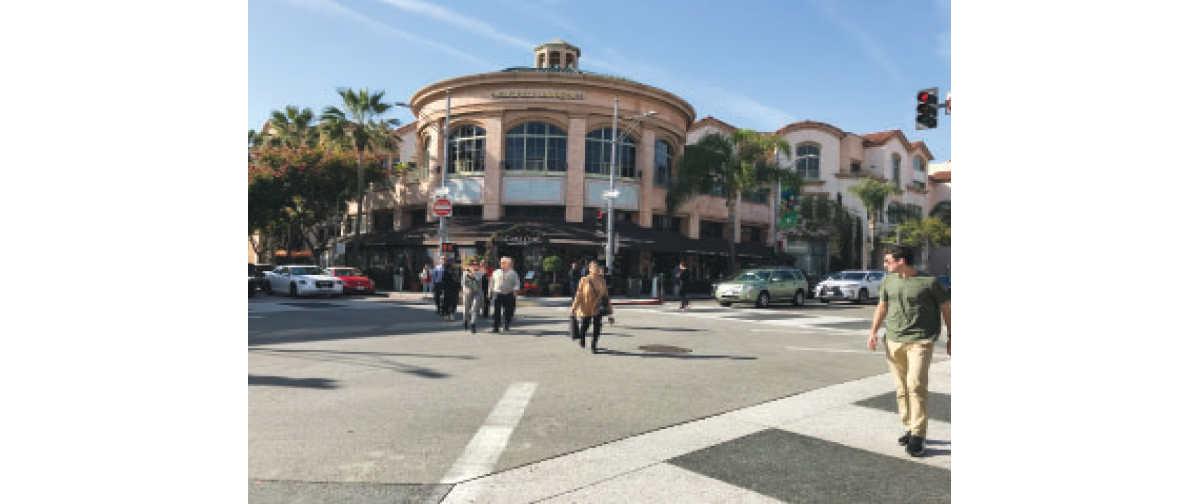In response to a request from local merchants to help ease the consequences of the closure of Canon Drive north of Wilshire Boulevard, on Tuesday, Dec. 10, the Beverly Hills City Council unanimously voted to convert Dayton Way to a two-way street between Crescent Drive and Canon Drive. The Council also voted to eliminate the pedestrian scramble crosswalk at the intersection of Canon Drive and Dayton Way.
The 5-0 City Council vote followed a 3-1 vote by the Traffic and Parking Commission (TPC) to recommend the two-way street conversion to the Council.
“We need to do this,” said Councilwoman Lili Bosse. “I think this is urgent and I think we need to do this. The goal is to make it so people can use the businesses in the area.”
Even before Metro Purple Line construction work forced the creation of the North Canon Drive cul-de-sac at Wilshire Boulevard for an anticipated three-year period this past fall, Beverly Hills businesses around the area had been requesting the conversion for that one block in order to access the 9631 Dayton Way City-owned parking garage from Crescent Drive. Following the Canon closure, the urgency became greater, with merchants citing resulting negative impacts to their businesses.
Beverly Hills Market & Deli owner Shawn Saeedian estimated that his business dropped by 20 percent following the closure.
“Since Canon has been closed at Wilshire, businesses on the surrounding streets have felt that access to their stores has been affected,” said TPC Chair Jay Solnit. “By opening Dayton two ways, we hope this will help alleviate the problem.”
City staff used traffic forecast modeling software to determine that there would be a delay of several minutes at the intersection of Dayton Way and Canon Drive from the conversion, with very little predicted delay at the other intersections. A more detailed study conducted by Fehr & Peers showed that “vehicle delay would be much higher than currently occurs” with the two-way conversion. The study also showed that removing the pedestrian scramble would reduce vehicle delay.
“The two-way conversion would provide additional circulation opportunities, including improved access to the City-owned parking garage,” states the Fehr & Peers report.
However, the study also found that the conversion “would result in substantial additional delay during the PM [sic] peak hour at the N. Canon Drive and Dayton Way intersection.”
The study estimated that during peak evening traffic times, making Dayton a two-way street, in tandem with the Canon closure, would significantly augment traffic delays at the N. Canon Drive and Dayton Way intersection, with an anticipated delay time of 340 seconds (over five-and-a-half minutes.)
“The combination of the capacity reduction on eastbound Dayton Way (one through travel lane in comparison to two lanes currently) and the new signal phase required for the westbound approach would result in vehicle demand exceeding the intersection capacity,” according to the study.
The Fehr & Peers study notes that vehicles are likely to change their travel path when the delay is high.
Before the vote, TPC Commissioner David Seidel, the Commission’s one dissenting vote on the two-way conversion, told the Council: “I think the argument that the businesses are suffering a life and death existential crisis because they can’t access the driveway off of Dayton is not correct and I don’t believe there’s data to support that.”
As part of the conversion, the City is slated to do the following: remove the existing lane lines to install new double yellow centerline striping on Dayton Way; remove a total of two parking spaces on Dayton Way to widen the travel lanes and improve traffic flow; upgrade traffic signal equipment at Canon Drive/Dayton Way and Crescent Drive/Dayton Way; and replace parking and traffic signage.
While removing the pedestrian scramble is expected to offset some of the anticipated delays associated with making that stretch of Dayton Way a two-way street, it does come with an associative risk for pedestrians. Councilman Julian Gold, who said he would only create the two-way street if the scramble was removed due to the significant expected 340-second delay, insisted that staff monitor the impacts. Further, he said it was imperative that there be a re-evaluation of the decision to remove the scramble if the City sees any uptick in pedestrian injuries.
The Public Works Department estimated that that it would take two to three months to implement the conversion at a cost of approximately $150,000.
TPC Commissioner Nooshin Meshkaty, who recused herself from the TPC vote, told the Council she hoped Metro would “pick up the cost because this is associated with a problem that they’re causing in our City.”







